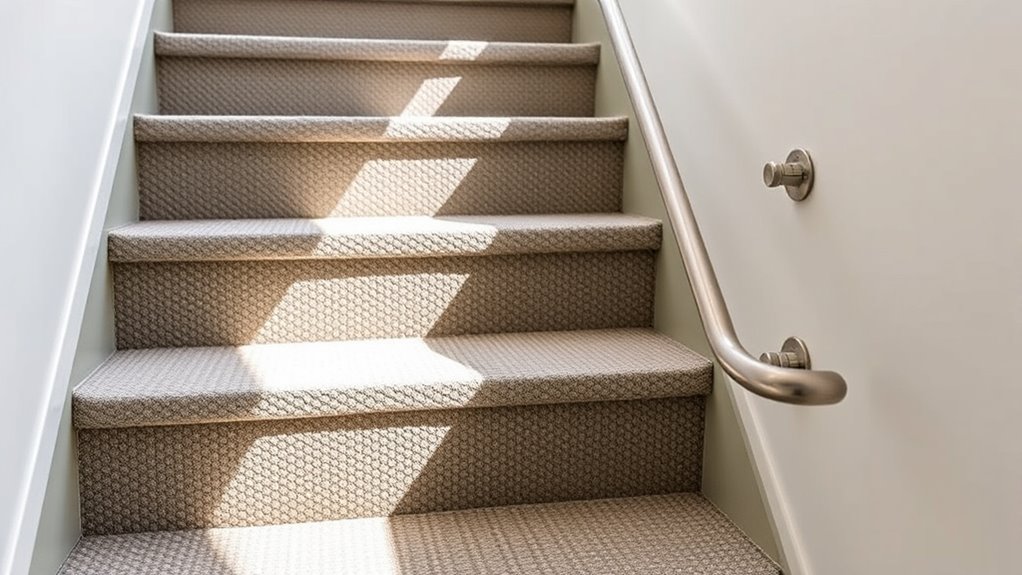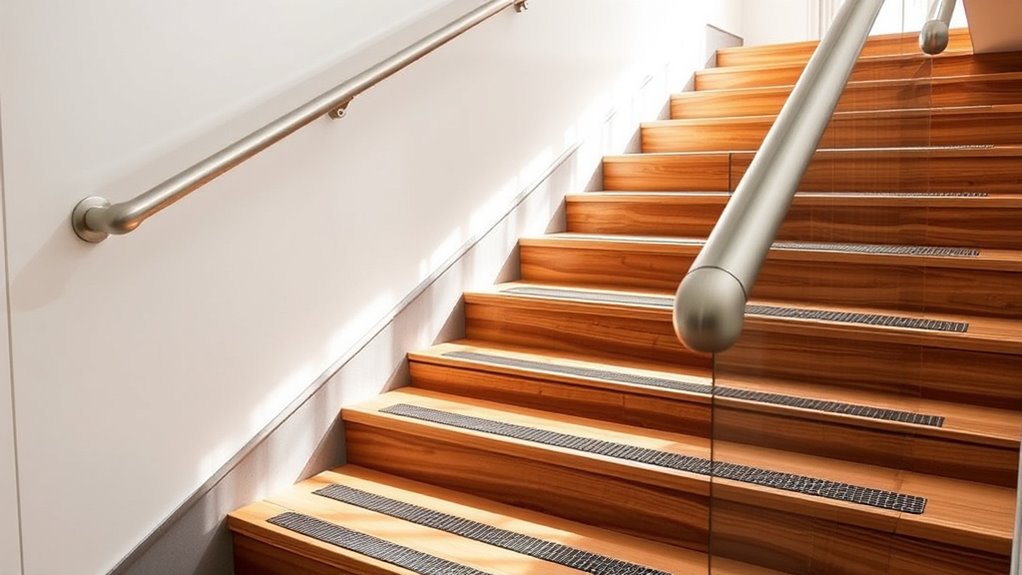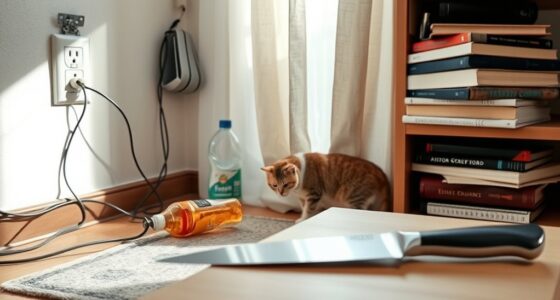To improve stair safety and install grab bars, make sure your stairs have sturdy handrails at the right height, between 34-38 inches above the treads, and guarantee they are securely fastened. Add proper lighting to eliminate shadows, and consider installing slip-resistant strips. When installing grab bars, choose durable materials like stainless steel or textured surfaces and place them where they’re easily reachable. Continue to explore effective tips to create a safer staircase environment.
Key Takeaways
- Install grab bars between 33-36 inches above the stair treads for optimal support.
- Use sturdy, corrosion-resistant materials like stainless steel or reinforced plastic for durability.
- Ensure grab bars are securely anchored into wall studs or appropriate anchors to prevent movement.
- Position grab bars at strategic locations, such as stair entry and landing areas, for maximum safety.
- Regularly inspect and maintain grab bars to ensure they remain secure and effective.

Stairs are a common part of many homes, but they can pose safety risks if not properly maintained. One of the most effective ways to enhance safety is by ensuring your staircase has sturdy handrails and good lighting. The handrail materials you choose play a vital role in both safety and aesthetic appeal. You want a handrail that’s strong, durable, and comfortable to grip. Metal options like stainless steel or aluminum are popular because they are sturdy and resistant to wear. Wood handrails offer a traditional look and are easy to grip, but make sure they’re smooth and securely attached. For added safety, some homeowners opt for handrails with textured or rubberized surfaces, which provide better grip, especially if your hands get sweaty or if you have limited grip strength.
Lighting your stairs properly is equally important. Good stair lighting reduces the risk of missteps and accidents, particularly at night or in dimly lit areas. You should install lighting that evenly illuminates each step, avoiding shadows that can cause confusion or missed steps. LED strip lights placed along the underside of handrails or along the edges of stairs are discreet and effective. Recessed lighting fixtures embedded into the wall or ceiling can also work well, especially if they are adjustable so you can direct light precisely where needed. It’s smart to avoid relying solely on ceiling fixtures that may cast shadows on the steps. Instead, consider a layered approach—using wall sconces, stair tread lighting, or motion-activated lights to make sure every part of your staircase remains clearly visible at all times. Additionally, adequate lighting can help prevent falls by improving overall visibility.
In addition to choosing the right handrail materials and improving stair lighting, ensure your handrails are installed at the correct height, usually between 34 and 38 inches above the stair tread. Proper placement allows you to grip the handrail comfortably, providing stability when ascending or descending. Regularly check your handrails and lighting fixtures to make sure they’re secure and functioning properly. Loose handrails or burnt-out bulbs can turn a safe staircase into a hazard. Remember, safety isn’t just about preventing falls; it’s about creating a space where you feel confident using your stairs every day. By paying attention to the materials you choose and making sure your stairs are well-lit, you’ll considerably reduce the risk of accidents and make your home safer for everyone.
Frequently Asked Questions
What Are the Best Materials for Grab Bars?
You should choose stainless steel for grab bars because of its excellent material durability and resistance to corrosion, ensuring long-lasting safety. If aesthetics matter, consider options like powder-coated metals or brushed nickel, which offer sleek finishes and a variety of styles. These materials not only provide strength and stability but also blend seamlessly with your decor, making your stairs both safe and visually appealing.
How Do I Choose the Right Height for Grab Bars?
You should choose grab bar height based on height considerations and user comfort. Typically, install the bars so they’re around 33 to 36 inches above the stair tread or floor, ensuring easy gripping. Adjust for individual needs—if someone has limited mobility or uses a wheelchair, tailor the height accordingly. Prioritize comfort and stability, making sure the grab bars provide reliable support without causing strain during use.
Can I Install Grab Bars Myself or Need a Professional?
You can definitely do a DIY installation of grab bars if you feel comfortable with basic tools and skills. Just follow manufacturer instructions carefully to make certain of proper placement and secure mounting. However, for added safety and peace of mind, especially if you’re unsure about the wall material or structural support, it’s wise to seek professional assistance. Professionals can guarantee the grab bars are installed correctly and safely.
Are There Specific Regulations for Stair Safety in Public Buildings?
Yes, public buildings must follow specific regulations for stair safety, including standards for handrail design and stair tread dimensions. You need to guarantee handrails are continuous, properly supported, and meet height requirements. Stair tread standards specify the minimum depth and riser height for safety and accessibility. These regulations help prevent accidents and ensure compliance, so it’s vital to consult local building codes or professionals when planning or modifying stairs in public spaces.
How Often Should Grab Bars Be Inspected or Replaced?
You should inspect your grab bars at least once a year and replace them if you notice any damage or looseness. Studies show that proper maintenance can reduce fall risks by up to 50%. Your maintenance schedule must consider material durability—stainless steel lasts longer than plastic, for example. Regular checks guarantee they remain secure and functional, keeping you safe and preventing accidents on stairs.
Conclusion
Making your stairs safer by installing grab bars can considerably reduce fall risks; in fact, studies show that proper grab bar placement can cut fall-related injuries by up to 85%. By taking these simple steps, you’re not only protecting yourself but also creating a safer home environment. Remember, safety doesn’t take a break, and investing in grab bars is a small change that can make a huge difference. Stay cautious and prioritize your well-being every day.









